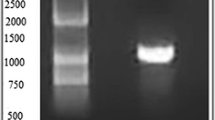Abstract
The present study deals with the transformation of L-tyrosine to L-dopa by Acremonium rutilum, a fungal tyrosinase producer, isolated from decomposed banana stud. This appears to be the first report on A. rutilum as a polyphenoloxidase producer with both cresolase and catecholase activity. Enriched Czapek-Dox agar was used for plate assay screening. Enriched potato dextrose broth was used for optimization studies, which induced high levels of L-dopa under submerged fermentation. A. rutilum gave the maximum L-dopa production (0.89 mg/ml) and tyrosinase activity (1095 U/mg) under the optimized parameters, that is, a temperature of 25°C, pH 5.5, an inoculum size of 2.5 ml, and an incubation time of 72–120 h, with L-tyrosine (5 mg/ml) as substrate. Five resolved bands, with Rf values of 0.73, 0.60, 0.54, 0.37, and 0.26, were observed, which confirmed the presence of L-dopa. This study involves the elevated profile of L-dopa production. Such study is needed, as L-dopa has the ability to control Parkinson’s disease.






Similar content being viewed by others
References
Lee SG, Hong SP, Sung MH (1999) Development of an enzymatic system for the production of dopamine from catechol, pyruvate and ammonia. Enzyme Microb Technol 25:268–302
Koyanagi T, Katayama T, Suzuki H, Nakazawa H, Yokozeki K, Kumagai H (2005) Effective production of 3,4-dihydroxyphenyl L-alanine (L-dopa) with Erwinia herbicola cells carrying a mutant transcriptional regulator TyrR. J Biotechnol 115:303–306
Haneda K, Takeda I (1974) Activation of the enzyme of Aspergillus oryzae catalyzing the conversion of L-tyrosine to L-3,4-dihydroxyphenylalanine. J Ferment Technol 52:106–113
Para GM, Baratti JC (1984) Effect of culture conditions on the production of tyrosine phenol-lyase by Erwinia herbicola. Appl Environ Microbiol 48:1256–1258
Lerch K (1981) Copper monooxygenases: tyrosinase and dopamine 1-monooxygenase. In: Siegel H (ed) Metal ions in biological systems, vol 13. Marcel Dekker, New York, pp 143–186
Horowitz NH, Shen SC (1952) Neurospora tyrosinase. J Biol Chem 197:513–520
Wichers HJ, Gerritsen YA, Chapelon CGJ (1996) Tyrosinase isoforms from the fruit bodies of Agaricus bisporus. Phytochemistry 4:333–337
Ali S, Jeffry S, Haq I (2007) High performance microbiological transformation of L-tyrosine to L-dopa by Yarrowia lipolytica NRRL-143. BMC Biotechnol 7:50
Sukumaram CP, Singh DV, Khedkar PD, Mahadevan PR (1979) An actinomycete producing L-3,4-dihydroxyphenylalanine from L-tyrosine. J Biosci 1:236–239
Reinhold DF, Utne T, Abramson NL (1987) Process for L-dopa. U.S. patent 4716246
Swiss Industrial Biotechnology, Swiss Biotech Association, Bern. Available at: http://www.swissbiotechassociation.ch/files/membersadd/O.Ghisalba.pdf
Maria GL, Sridhar KR, Raviraja NS (2005) Antimicrobial and enzyme activity of mangroove endophytic fungi of southwest coast of India. J Agr Technol 1:67–80
Mohammad AF, Mojitaba TY, Abbas S, Gholamreza Z (2002) Microbial transformation of hydrocortisone by Acremonium strictum PTCC528267. Steroids 67:869–872
Gouka RJ, Heiden MV, Swarthoff T, Verrips TC (2001) Cloning of a phenol oxidase gene from Acremonium murorum and its expression in Aspergillus awamori. Appl Environ Microbiol 67:2610–2616
Cubo MT, Buendia-Claveria AM, Beringer JE, Rufz-Sainz (1988) Melanin production by Rhizobium strains. Appl Environ Microbiol 54:1812–1817
Raper HS (1926) The tyrosinase–tyrosine reaction (production of L-3,4-dihydroxy phenylalanine from tyrosine). Biochem J 20:735–742
Fling M, Horowitz NH, Heinemann SF (1963) The isolation and properties of crystalline tyrosinase from Neurospora. J Biol Chem 238:2045–2053
Maria A, Galeazzi M, Valdemiro C, Garbieri S, Spiros M (1981) Isolation, purification and physicochemical of polyphenol oxidase (PPO) from a dwarf variety of banana (Musa cavendishii L.). J Food Sci 46:150–155
Arnow LE (1937) Colorimetric determination of the components of L-3,4-dihydroxyphenylalanine-tyrosine mixture. J Biochem 118:531–537
Lowry OH, Rosbrough NJ, Farr AL, Randall RJ (1951) Protein measurement with the folin phenol reagent. J Biol Chem 193:265–275
Gulendem G, Fahrunnisa P (1999) Thin layer chromatographic separation and quantitation of L-dopa and L-tyrosine in mixtures. Turk J Chem 23:269–273
Mason HS (1948) Mechanism of the oxidation of dihydroxyphenylalanine by tyrosinase. J Biol Chem 172:83–99
Haq I, Ali S (2002) Microbiological transformation of L-tyrosine to 3,4-dihydroxyphenyl L-alanine (L-dopa) by a mutant strain of Aspergillus oryzae UV-7. Curr Microbiol 45:88–93
Raper HS (1938) Problems in tyrosinase metabolism. J Chem Soc 125–130
Haneda K, Watanabe S, Takeda P (1973) Production of L-3,4-dihydroxy-phenylalanine from L-tyrosine by microorganisms. J Ferment Technol 51:398–406
Olsen W (1981) Characterization of enzymes using catecholamines. Sugar J 83:102–105
Evans WC, Raper HS (1937) A comparative study of the production of L-3,4-dihydroxy phenylalanine from tyrosine by tyrosinase from various sources. Biochem J 31:2155–2166
Ali S, Haq IU, Qadeer MA (2002) Novel technique for microbial production of 3,4-dihydroxyphenyl L-alanine by a mutant strain of Aspergillus oryzae. Electron J Biotechnol 5:118–124
Lee SG, Rao HS, Hong SP, Kim EH, Sung MH (1996) Production of L-dopa by thermostable tyrosine phenol-lyase of a thermophilic Symbiobacterium spp. over expressed in recombinant Escherichia coli. J Microb Biotechnol 6:98–102
Haq I, Ali S, Qadeer MA, Iqbal J (2003) Inductive effect of cresoquinone on microbiological transformation of L-tyrosine to 3,4- dihydroxyphenyl L-alanine by Aspergillus oryzae NG11(p1). Appl Microbial Biotechnol 60:696–699
Maurice R, Marshall, Kim J, Cheng-I Wei (2000) Enzymatic browning fruits, vegetables and seafoods. Available at: http://www.fao.org/ag/ags/agsi/ENZYMEFINAL/COPYRIGH.HTM
Foster M, Brown SR (1957) The production of dopa by normal pigmented mammalian skin. J Biol Chem 225:247–252
Acknowledgment
The first author is thankful to Gulbarga University, Gulbarga, for the award of a merit studentship and UGC for the award of Research Fellowship.
Author information
Authors and Affiliations
Corresponding author
Rights and permissions
About this article
Cite this article
Krishnaveni, R., Rathod, V., Thakur, M.S. et al. Transformation of L-Tyrosine to L-Dopa by a Novel Fungus, Acremonium rutilum, Under Submerged Fermentation. Curr Microbiol 58, 122–128 (2009). https://doi.org/10.1007/s00284-008-9287-5
Received:
Accepted:
Published:
Issue Date:
DOI: https://doi.org/10.1007/s00284-008-9287-5




